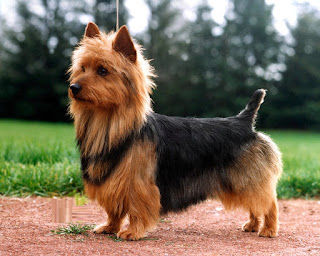Introduction:
The Australian Terrier was developed in Australia. The dog is a terrier breed, especially used as a earth dog. The life span of the Australian Terrier is 12-14 years. It is also called as Aussie as its nick name.

Origin / History:
The Australian Terrier is courageous, vigilant and alert dog. They like to bark. They are quick learners. They are brave, lively and self-confident. They become happy when able to romp and play. They are people friendly and enjoy interacting with people. They are usually good with older children.
Physical Appearance:
The height of Australian Terrier is 9-11 inches (23-28 cm) and weight is 9-14 pounds (4-6 kg). The Australian Terrier is a small and sturdy dog. The eyes are small with dark brown and black color. The nose is dark. They have small ears that are erect and pointed. The tail is docked to half its length and it is carried high but not over the back. The color of the breed may be blue with tan markings, clear sandy or red.
Health Concerns:
The Australian Terrier is generally a healthy breed that lives many years.
Grooming:
Weekly brushing should be done nicely and also some trimming around the feet and ears will keep this dog look neat and clean.
Cost:
The cost of purchasing this breed is $ 475 USD
Advantages:
Disadvantages:
The Australian Terrier was developed in Australia. The dog is a terrier breed, especially used as a earth dog. The life span of the Australian Terrier is 12-14 years. It is also called as Aussie as its nick name.

Origin / History:
- The Australian Terrier was developed in the 19th century by Australians
- The Australian Terrier was welcomed for his skills at dispatching the hated rabbit and killing the snakes
- Aussie dogs and their shrill barks were also once ideal for their use as watchdogs on a frontier that still contained real dangers, well into the 20th century.
The Australian Terrier is courageous, vigilant and alert dog. They like to bark. They are quick learners. They are brave, lively and self-confident. They become happy when able to romp and play. They are people friendly and enjoy interacting with people. They are usually good with older children.
Physical Appearance:
The height of Australian Terrier is 9-11 inches (23-28 cm) and weight is 9-14 pounds (4-6 kg). The Australian Terrier is a small and sturdy dog. The eyes are small with dark brown and black color. The nose is dark. They have small ears that are erect and pointed. The tail is docked to half its length and it is carried high but not over the back. The color of the breed may be blue with tan markings, clear sandy or red.
Health Concerns:
The Australian Terrier is generally a healthy breed that lives many years.
Grooming:
Weekly brushing should be done nicely and also some trimming around the feet and ears will keep this dog look neat and clean.
Cost:
The cost of purchasing this breed is $ 475 USD
Advantages:
- They are excellent vermin destroyers
- It is beloved and faithful house pet
Disadvantages:
- They are stubborn
- Do not tolerate teasing from children
- They are dog-aggressive with other terriers



